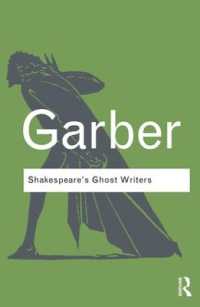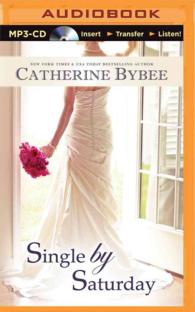- ホーム
- > 洋書
- > 英文書
- > Literary Criticism
Full Description
Bohemian Jewish culture and literature during the underexamined 1820s to 1880s.
This book on Jewish culture and literature focuses on the "quiet" decades of the nineteenth century, a scarcely written-about period of time in Bohemian Jewish history. Using a myriad of sources, including travelers' accounts, poems, essays, short stories, guides, and newspaper articles, the volume explores Jewish expression, Jewish-Czech relations, and the changing attitudes toward Jews between the 1820s and 1880s. It offers close readings of writers like Karel Havlíćek Borovský, Ján Kollár, Siegfried Kapper, and Jan Neruda, as well as lesser-known authors and sources. Combining skillful sustained analysis, judicious argumentation, and elegant writing, the book is a truly enriching reading experience.
Contents
1. Bohemia's Configurations
1.1. The Three-Box Game
1.1.1. Revival: Czechs
1.1.2. Emancipation: Jews
1.1.3. Under Pressure: Germans
1.2. And Beyond the Boxes
1.2.1. Who Was Really What and When?
1.2.2. Translocal Horizons: Bildung
1.2.3. Who Kept an Eye on Whom?
1.2.4. In Between or Out?
2. Prague's Jewish Town as Represented Space, 18303-1840s
2.1. Domestic Gazes: Jews Outside the Ghetto
2.1.1. A Medical Map of (Jewish) Prague: F. A. Stelzig, 1824
2.1.2. Again, Jews Outside the Ghetto: K. V. Zap, 1835
2.1.3. Jews Spying in Cafés: S. W. Schießler, 1812
2.1.4. Observing the Contact Zone: Karolina Svetlá, 1840s
2.2. Stop-Over Gazes
2.2.1. A Not So Elegant World: Gold and Refuse as of 1829
2.2.2. English Travelers: Henry Reeve, 1837
2.2.3. English Travelers: George Robert Gleig, 1837
2.3. Jewish Voices
2.3.1. A Ghetto Home: Siegfried Kapper
2.3.2. Ghetto Physiognomy: Leopold Weisel
2.3.3. Purim in the Ghetto: H. J. Landau's Decency
2.3.4. Purim in the Ghetto: J. Kaufmann's Nostalgia
2.4. More Angles of View
3. Making Sense of a Ruin: The Old Jewish Cemetery in Prague
3.1. Old Agendas
3.1.1. Early Sources
3.1.2. The Cemetery as a Philological Exercise
3.2. New Agendas
3.2.1. The Emergence of a Romantic Cemetery
3.2.2. The Cycle of Life
3.2.3. The Cemetery as a Site of Othering
3.2.4. The Cemetery as a Site of a Jewish Conspiracy
3.3. Threads of Memory Emerging
3.3.1. A Czech Romantic's Empathy
3.3.2. Jewish Work on Jewish Memory
3.4. Dialectics of Fragmentation
4. To Include or Not to Include? Kollár's and Mácha's Conflicted Answers
4.1. Jan Kollár's Answers
4.1.1. A Pastor's Missionary Dream
4.1.2. Sláva's Exclusionary Pantheon
4.1.3. Pragmatic Packaging
4.2. Karel Hynek Mácha's Answers
4.2.1. Orientalism in the Service of the Nation
4.2.2. More than an Allegory
4.2.3. Practical Matters—Exclusion
4.3. Pragmatic Packaging Again
5. Shock and Entertain: Diversions for Gentiles and/or Jews
5.1. Old Farces
5.2. New Plots ...
5.2.1. Tragic Tragedies—Transgressing Women Die
5.2.2. Melancholic Tragedies—Jews Leave the Stage
5.2.3. Happy-Ending Tragedies 1: Hurray, She Is Not Jewish!
5.2.4. Happy-Ending Tragedies 2: Hurray—He Is Jewish
5.3. ...and Their Characters
5.3.1. Jewish Daughters—What They Look Like
5.3.2. Jewish Fathers—Mostly Ugly
5.3.3. Gentile Lovers—Just a Necessity
5.4. Licensing the New Jewish Configuration
5.5. Melodramas and Their Contexts
6. Varieties of Bohemian Jewish Literature
6.1. Goethe, Bohemia, Jewish Authors
6.1.1. How Goethe Saw Bohemian Authors
6.1.2. How Jewish Authors Saw Goethe
6.2. Bohemian Jews About Bohemian Jews
6.2.1. A Literature by Schoolmasters
6.2.2. Selig Korn's Magic Lantern
6.2.3. Leopold Weisel's schnorrer
6.3. Bohemian Jews About Jews and Czechs
6.3.1. Empathy: Jacob Kaufmann
6.3.2. Melancholy: Leopold Kompert
6.4. The Local, Legends in Particular
6.5. Institutions of Reading
6.5.1. Pascheles' Sippurim
6.5.2. Calendars
6.6. Variety, Complexity, Choices
7. The Imperial and the Local: Frankl vs. Kapper
7.1. Briefly About Ludwig August Frankl
7.2. Siegfried Kapper
7.2.1. Czech Leaves (1846): Structure and Themes
7.2.2. A Brief Kapper-Frankl Conversation
7.2.3. Kapper's Points of Reference:
Landespatriotismus and/or Reform Judaism?
7.2.4. Dedications and Beyond
7.2.5. A Jewish Response: Tefiltot Jisro'el in Czech
7.3. Steps to Rapprochement
8. New Debates about Jews: The 1840s
8.1. Old Debates
8.2. New Debates
8.2.1. Agendas of 1844-1845
8.2.2. Kuh/Nebeský: A Project of Rapprochement
8.2.3. Some Czech Responses
8.3. Karel Havlícek—"A Fanatic of the Nineteenth Century"
8.3.1. Jews as Aliens
8.3.2. Jews as Bad Poets: Shouting and Cheating
Screamers and Surrogate Makers
8.3.3. Critical Reactions
8.3.4. End of Debates?
Havlícek on Jewish Emancipation, 1850
8.4. The Rapprochement Project: Strengths and Contradictions
9. Languages of 1848
9.1. Genres, Media, Performances
9.1.1. The Prelude of 1844
9.1.2. Mourning: High Style
9.1.3. Singing: Revolutionary Style
9.1.4. The Street as a Space of Communication
9.1.5. The Street as a Space of Verbal Assault
9.2. The (Emotional) Medium is the Message
10. In Search of an Enemy: Jews According to Jan Neruda Strategies of Recoding
10.1. The Tract
10.1.1. Structure
10.1.2. Themes
10.1.3. Sources and References
10.1.4. Radicalism: Beyond "Good Behavior"
10.2. Beyond the Tract: Loyalty Undivided
10.3. Beyond the Tract: The role of Beauty and Manliness
10.3.1. Jerusalem vs. Belgrade
10.3.2. Kuranda vs. Smolka
10.4. Language
10.5. Reactions and Reinforcements
10.6. Legacy
10.7. To Close the Case: Antisemitism
11. New Times: Jewish, Czech, Jewish-Czech
11.1. New Jewish Times-in German
11.1.1. Jewish Pride: Marcus Teller
11.1.2. The Journals of the 1860s
11.2. New Czech Times-with Jews
11.2.1. Jews in Czech Narratives: J. J. Kolár
11.2.2. Jews in Czech Legends
11.3. New Jewish Times-with Czechs and in Czech
11.3.1. The Czech-Jewish Movement and Its Calendar
11.3.2. The Languages of Or Tomid
11.3.3. Czech Academic-Jews and Czech Politicians
11.3.4. Literature as a Tool of Acculturation Politics:
From Kapper to Rakous
11.4. A Conclusion








